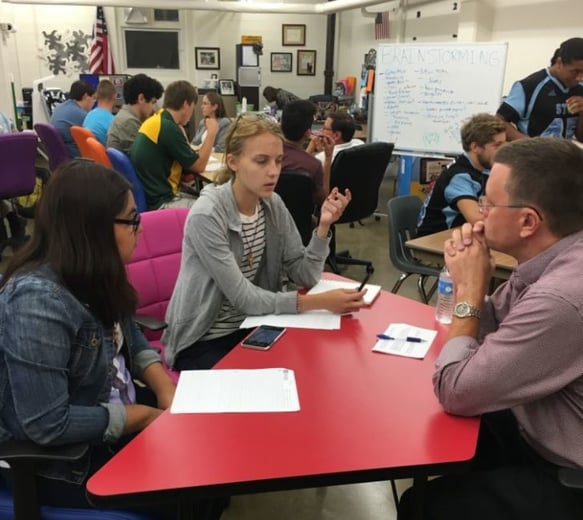Sharon Tomski is a PLTW Engineering Design and Development (EDD) Master Teacher and STEM Coordinator at St. Thomas More High School in Milwaukee, Wisconsin. Sharon is a chemical engineer and retired Navy Commander.
The horn blares. “Time’s up,” I announce over the noise of excited conversation. The students reluctantly shake hands with the professional at their table and thank them for their help. The four-minute process starts over again as the student team introduces themselves to the engineer at the next table and prepares to scribble down ideas.
This process is similar to popular networking events, where attendees are encouraged to meet a large number of people in a short time period. Our purpose, however, is for the Engineering Design and Development (EDD) students to generate a large number of problem ideas in a short time.
To begin, students brainstormed topics on their own. What areas or populations of the world need innovation the most? What have they always wanted a solution for? What parts of societal living don’t make sense? What inconveniences are people just living with, instead of fixing? With their notebooks filled with general ideas of problems and topics, the students then shared their ideas with their classmates. In groups, the students refined and added to each idea. Furthermore, they identified concrete and specific problems within the topics during this first brainstorming session.
The next step involved reaching out to the extensive knowledge base of professionals in various engineering, science, and technology fields.
To facilitate a rapid exchange of ideas, I developed a way to utilize the extensive expertise of St. Thomas More’s PLTW Partnership Team and alumni: Engineer Speed Networking. Professionals in electrical, project management, civil, mechanical, and medical fields from local firms such as Badger Meter, Collins Engineers, TRC Solutions, the City of Milwaukee, and Electro Kinetic Technologies participated. The professionals sat on the outside of a circle of tables while the EDD students rotated on the inside. During each four-minute meeting, students introduced their thoughts to the engineers, and the engineers helped relate the ideas to real-world problems and possible solutions. Students heard real-life examples of engineering processes and workflow, trial-and-error situations, and teamwork.
This exercise allowed students to collaborate with professionals and to build connections in the field. Their ideas were refined and expanded to truly reflect a problem that need to be addressed in our society. Both students and engineers came away from the event excited and enthusiastic about continuing to use the design process to develop solutions.
PLTW’s blog is intended to serve as a forum for ideas and perspectives from across our network. The opinions expressed are those of each guest author.

